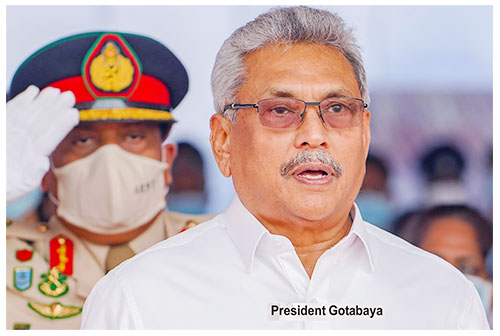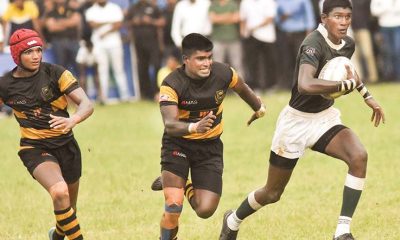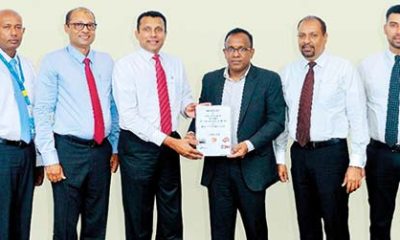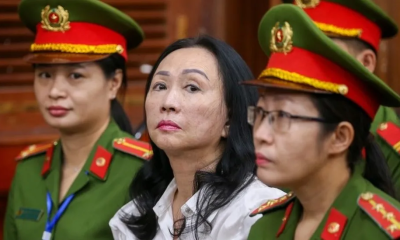Midweek Review
Give him a breather

By Rohana R. Wasala
Sri Lankan Catholics, led by His Eminence Malcom Cardinal Ranjith, Bishop of Colombo, marked Black Sunday on March 7, with the participation of representatives from Buddhist, Hindu, Christian and Muslim religious communities, demanding justice for the victims of the Easter Sunday suicide bomb attacks carried out by local Islamist Jihadists two years ago. The Archbishop threatened further activism including asking for international help unless there emerge sure signs before April 21 that the real masterminds behind the horrendous crime are clearly identified and duly punished so that no repetition of the like will occur in the future. The event was immediately provoked by what was perceived by them and members of the Opposition as well as some law-makers of the ruling alliance, and sections of the civil society, as foot-dragging by the government over punishing the guilty.
That questionable perception was prompted by the President’s appointment on February 19 of a six-member ministerial committee to study the Final Report of the Presidential Commission of Inquiry into Easter Sunday attacks which had been presented to him nearly three weeks before, and also the report submitted to Parliament by the Sectoral Oversight Committee on National Security. (I, for one, do not question the appropriateness of the president’s move; it must be part of the proper procedure he has chosen to deal with the matter. Considering the dismal history of commissions of inquiry in our country, which a past left politician in Parliament likened to a ‘loo visit’ – sitting, deliberating, reporting and dropping the matter, what is at present happening under President Gotabaya is quite efficient quick.) The ministerial committee was required to hand over its report before March 15. Committee member Minister Prasanna Ranatunga said yesterday (March 8) that the report will be submitted on March 15, as scheduled. The PCoI was appointed by (previous) President Sirisena in September, 2019, and its term was extended several times by incumbent president Gotabaya without introducing any change to the composition of its membership. It is not likely that the unacceptable practice of interfering with the judiciary or in legal processes for which the previous yahapalanaya was severely criticised and was made to pay a heavy price in the form of a humiliating electoral defeat would be repeated by the present government, especially by Gotabaya, given his unsullied professional record and his immaculate personal probity. (Incidentally, something I observed in Gotabaya’s campaign speeches in Sinhala was his studied avoidance of noncommittal promissory statements containing (First Person Singular) verbs ending in the suffix -nnam, e. g., karannam (I shall/will do); he always used the present affirmative forms like ‘mama karanawa’ ‘I do’ instead of the future optative ‘karannam’ (I’ll do) form; ‘karanawa’ expresses a solemn pledge, not a casual promise. Gotabaya has already amply proved that he is a man of his word, just as much as he is a man of action.) Meanwhile, it is unlikely that the Cardinal has lost his trust in the President, who had repeatedly reassured him that the culprits won’t be allowed to go free, though the former has found it fit to observe a Black Sunday. That must be to provide a shot in the arm for the President and the government to reaffirm their commitment and renew their resolve for expediting the commencement of due processes for ultimately meting out justice to all affected persons; but that kind of coaxing is redundant, in my opinion.
A day before the Black Sunday was marked (i.e., Saturday 6), the President held the 13th session of his ‘Gama Samaga Pilisandara’ ‘Conversation with the Country’ programme with the people of the village of Giribawe, Weragala, in Kurunegala. He had a copy of the final report, and spoke turning its pages, which showed that he had a good idea of its contents. He explained to the people that he had got the report on February 1, and that the commission had been appointed by the previous President. President Gotabaya pointed out that the report clearly blamed the (Yahapalana) government; it identified governmental inefficiency as the principal contributory factor that led to the Easter Sunday attacks. He stressed the fact that the report apportioned blame not only to former President Sirisena and the ex-Premier (Ranil), but also to the government (that they headed).
‘But today’, he added, ‘those who were in that government speak as if they weren’t in it. During president Mahinda Rajapaksa’s time, we gave priority to state security…. This report makes it clear that a situation like this resulted from the discontinuance of that security framework. We completely reject the absurd, baseless allegation that our government must be held responsible for the Easter Sunday attacks … The Report has recorded who is accountable for them. It is our responsibility to see them punished, because we are the government now. We will properly execute that (duty). We have not only this report, but also (reports from) the CID, the TID, and intelligence sectors. Since we came to power, we have apprehended many other new suspects. We are continuing (with this process). Punishments will be meted out to these people and those.’
My feeling, for what it is worth, is that the President and the government must be allowed time and freedom to deal with the burning issues in the current unprecedented critical circumstances. A local, Sri Lanka-bashing, propagandist tabloid has started calling the President ‘Nandasena’ (from his full name ‘Gotabaya Nandasena Rajapaksa’). This is clearly meant to be derogatory, for it acoustically links him with his failed predecessor Sirisena, who in actuality, through his ungrateful 2014-November betrayal of his elder brother the then President Mahinda, has brought endless disaster to the country. Such inimical portrayal of President Gotabaya as a failure is wrong. (It is tragic that some prominent monks who helped bring Gotabaya to power, have now been duped into looking away from him in apparent disillusion and defend Sirisena instead who is being justly threatened with possible prosecution in connection with the Easter Sunday attacks). With a little hindsight Gotabaya supporters may draw fresh inspiration.
The newly elected President Gotabaya Rajapaksa handled with aplomb the sham kidnap episode which had been staged, courtesy the Swiss Embassy in Colombo on November 25, 2019, and which had certainly been meant to embarrass and undermine him internationally. The alleged abduction and rape of a local female employee of the Embassy was soon revealed by the police to have been a hoax, driven by anti-Sri Lanka politics. Having been elected President without a burdensome backpack of a professional political background, he was able to adopt a confident, unperturbed, and matter-of-fact approach to get at the truth, and suitably dispose of the filthy stuff. The naive Embassy officials who had been taken for a ride by the plotters of the hoax had egg on their faces; but the President treated them with the respect that their posts deserved, without any rancour. He even offered them a piece of friendly advice about the importance of guarding against being misled by fabrications of liars against the country (or something to that effect).
Currently, a worse, more damaging, drama is being acted out by the powers that be centering on the release of the Final Report of the Presidential Commission of Inquiry on the Easter Sunday Attacks. This must be intended to bamboozle the SLPP government under Gotabaya’s presidency to veer off its course into floundering in the stormy seas of geopolitics. This time however, the issue that is to be tackled is not so straightforward as the silly embassy skit. It will need Gotabaya’s hard-nosed practical approach as well as a seasoned politician’s pragmatism. Unfortunately, according to my lights, at present, Gotabaya is not getting the undivided support of those who are closest to him, but who are apparently pulling in different directions, though their loyalty may be unquestioned; this is an unacknowledged dichotomy in the government’s inner circle, which is good for his and the country’s enemies.
This unnecessary division of opinion or lack of unanimity has significantly stymied the resolution of a range of issues including the trivial burial problem fraudulently blown into international proportions by Jihadist apologists. How the government ignominiously embarrassed itself through unnecessarily bungling the issue is now common knowledge. Mandatory cremation of Covid-19 dead was a sound scientific decision. It was just yesterday (March 8) that 9NEWS, the national news service of the Nine Network in Australia, reported Deputy Chief Health Officer Dr Chris Lease revealing at a press conference held the day before (March 7) that a ‘very strong positive’ COVID-19 sample had been detected in Adelaide’s wastewater and that in response to this South Australia had been put on coronavirus alert. Doesn’t this suggest that Sri Lankan experts’ caution regarding possible contamination of groundwater was correct? Mandatory cremation (condemned as ‘forced cremation’ by vested interests) was not politically motivated to hurt the feelings of a particular religious community.
The ad hoc use of plots of land on the edge of environmentally sensitive forest reserves for rural poverty alleviation in these hard times is a process that must be strictly supervised by state officials and utilized by a properly informed, responsible civilian population with the least environmental impact. This need not be a basis for attacks on the government. Of course, it is absolutely necessary to protect the forest reserves from endless encroachments in the future by unscrupulous elements. It is the authorities’ responsibility to turn the local beneficiaries of the concession into committed environment protectors. This can be done by injecting into them a dose of patriotism. Issues relating to the development of important sea ports with or without foreign collaboration, and the findings and recommendations of various commissions of inquiry appointed to look into bank scams, political victimizations, and the Easter Sunday attacks of April 21, 2019 should be dealt with as national issues that should not be mishandled inviting detrimental foreign intervention in our domestic affairs.
Midweek Review
Controversy over Katchatheevu ahead of Indian polls and Sirisena’s bombshell claim

Selection of targets, four in Colombo, one at Katuwapitiya, Negombo and one in Batticaloa, too, should have been investigated. The PSC never bothered to probe as to why the NTJ deliberately targeted a church in Batticaloa and the Tamil service at St. Anthony’s Church, Kochchikade. Over 60 Tamils worshippers perished in the Batticaloa and Kochchikade bombings. Over 100 received injuries. The deliberate targeting of the Tamil community was even ignored by the largest Tamil coalition, led by Illankai Thamil Arasu Kadchi (ITAK). Its spokesman and Jaffna District lawmaker M.A. Sumanthiran, a Christian, went to the extent of justifying the Easter Sunday carnage. President’s Counsel Sumanthiran did so at a public event held on April 29, 2019, at the BMICH. Why did the NTJ target both Sinhala and Tamil communities?
By Shamindra Ferdinando
Sri Lanka shouldn’t have been overly surprised by Indian Premier Narendra Modi’s declaration that Congress callously gave away the Katchatheevu Island to Sri Lanka.
Obviously, Premier Modi, eyeing a third term at the forthcoming general election (April 19 to June 1, 2024), wants to influence the crucial Tamil Nadu state. Modi lashed out at the Congress on March 31.
“Eye opening and startling! New facts reveal how Congress callously gave away Katchatheevu. This has angered every Indian and reaffirmed in people’s minds – we can’t ever trust Congress,”
Modi wrote on X obviously playing to the gallery, especially in Tamil Nadu. So, like most politicians, PM Modi, too, will stoop to any level.
The Bharathiya Janatha Party (BJP) leader also accused the Congress of weakening India’s unity. “Weakening India’s unity, integrity and interests has been Congress’ way of working for 75 years and counting,” Modi added.
External Affairs Minister S. Jaishankar reiterated Premier Modi’s concerns on the following day.
The Indian media reported that the issue at hand reemerged after a media report, based on an RTI reply received by Tamil Nadu BJP chief K Annamalai on the 1974 pact.
It was a meticulously planned propaganda project meant to influence the Tamil Nadu electorate, ahead of the general elections next week. Tamil Nadu goes to poll on April 19. The decision on the part of the BJP, in power since May 2014, to rake up this issue now, suggests that the BJP is under tremendous pressure.
Whatever errors the Gandhis may have committed during their long rule, yet no one can doubt their own zeal to hold a disparate country like India together, while still guarding its democratic foundations, unlike the unscrupulous West paying lip service to such ideals, while destabilizing any country that do not toe their domineering imperialist line. Nor can anyone deny the solid foundation they laid for India to become a global giant today in the fields of education, technology, industry, etc., despite its vast poverty.
The actual truth is that the BJP is clearly facing defeat once again in Tamil Nadu, where the Dravida Munnetra Kazhagam (DMK)-Congress alliance is expected to comfortably secure the majority of 39 Lok Sabha (Lower House) seats there and the one seat from Puducherry.
At the last general election, the DMK-led alliance won 38 out of 39 seats. Therefore, in spite of the Premier himself, and the much-respected and admired External Affairs Minister leading the BJP’s Tamil Nadu campaign, the outcome is very much unlikely to be in the ruling party’s favour.
India under Premier Indira Gandhi ceded Katchatheevu to Sri Lanka, in 1974, when she had such a good working relationship with our then PM Sirimavo Bandaranaike. It was several years before it began recruiting, training, arming and deploying Sri Lankan Tamil community against us, obviously to spite our then leader J. R. Jayewardene, known as Yankee Dickie because of his ardent pro-American views. JRJ was so arrogant, with his party commanding a 5/6 majority in our Parliament, he became blind to emerging regional realities and foolishly offered the Strategic Deep water Trincomalee harbour to the US, while his government members mockingly compared Mrs. Gandhi and her son Sanjay to Mrs. B. and her son Anura. When finally New Delhi militarily intervened here with an airdrop to force a halt to the first big ground operation at Vadamarachchi by the Lankan security forces to crush the Tigers in what was considered their lair, the Yankees failed to lift even a finger to save the JRJ government from humiliation. It would be pertinent to mention that India intervened here years before Sri Lanka’s conflict exploded, following the killing of 13 Lankan soldiers at Thinnaveli, in Jaffna, in July 1983. The often repeated claim that the war erupted, following the killing of ordinary Tamils, consequent to the Thinnaveli attack, is nothing but propaganda meant to justify separatist Tamil terrorist campaigns that at one time threatened to overwhelm Sri Lanka.
Sri Lanka should be ashamed of its failure to protect Tamil civilians. Instead of taking immediate measures to quell the violence, the then President J.R. Jayewardene, in his own wisdom, allowed killings and destruction of Tamil property.
The Indian intervention (Indian role in the killing of 13 soldiers by providing expertise and weapons) shouldn’t be used, under any circumstances, to justify attacks on the Tamil community, following the Thinnaveli attack, the first such ambush of a military patrol by Prabhakaran’s fast growing terrorist outfit, the LTTE.
Let me reproduce what late J.N. Dixit, who had served as Indian High Commissioner in Colombo (1985-1989) at the height of the Indian intervention here, said in his memoirs ‘Makers of India’s Foreign Policy: Raja Ram Mohun Roy to Yashwant Sinha’, launched in 2004, regarding the terrorist project here. Dixit didn’t mince his words when he found fault with the then Premier Indira Gandhi for two Indian foreign policy decisions. The relevant section verbatim: “…her ambiguous response to the Russian intrusion into Afghanistan and her giving active support to Sri Lankan Tamil militants. Whatever the criticisms about these decisions, it cannot be denied that she took them on the basis of her assessments about India’s national interests. Her logic was that she could not openly alienate the former Soviet Union when India was so dependent on that country for defence supplies and technologies. Similarly, she could not afford the emergence of Tamil separatism in India by refusing to support the aspirations of Sri Lankan Tamils.” (emphasis mine).
Dixit, hailing from neighbouring Kerala state, like so many of India’s top bureaucrats, served as Foreign Secretary (1991-1994) and National Security Advisor (May 2004-January 2005) before his sudden death. Dixit was 68 years old at the time of his death.
In hindsight, Indian military intervention in Sri Lanka cannot be justified under any circumstances. India and Indira Gandhi paid a huge price for that foolish decision to train terrorists. Likewise, Indian rhetoric over Katchatheevu Island shouldn’t be condoned though all know the BJP is playing politics to woo the fishing community vote there.
The boycotting of the two-day annual St. Antony’s Church festival at Katchatheevu, in late February this year, by Indian devotees, perhaps was influenced by interested parties in Tamil Nadu. Who would benefit from Tamil Nadu fishermen’s boycott of the religious event?
An absolute bombshell

Maithripala Sirisena
Just over a week before Premier Modi’s attack on Congress over the Katchatheevu affair, former Sri Lankan President Maithripala Sirisena declared that he was aware of the identity of the masterminds of the 2019 Easter Sunday massacre.
Sirisena, now an MP who represents the SLPP, told the Criminal Investigations Department (CID), a few days later, that he believed India engineered the Easter Sunday attacks. Sirisena, notorious for various unsubstantiated claims over the years, has asserted that the Easter carnage was meant to influence the Indian electorate during the previous general elections, conducted from April 11 to May 19, 2019.
At the time of the near simultaneous Easter Sunday blasts, Sirisena, his wife Jayanthi Pushpakumari, and other members of the then first family, were in Singapore. Controversy still surrounds whether the President was on a holiday or visiting Mount Elizabeth Hospital for a medical check-up, or both.
The President and members of his family flew to Singapore following a private visit to Tirumala, in Andhra Pradesh, to offer prayers at the hill shrine of Lord Venkateswara Swamy. Sirisena visited the shrine in February 2015 and August 2016, and the 2019 visit was his third.
What really prompted MP Sirisena to accuse India of masterminding the Easter Sunday terror project? Or who influenced the now beleaguered SLFP leader to make that accusation in Kandy?
Now the matter is before Maligakanda Magistrate Lochana Abeywickrema, who, on April 4, directed the CID to report the progress of the investigation to her Court on May 10. Pending the investigation, the statement recorded by the CID will remain confidential.
Did the 2019 Easter Sunday attacks have a bearing on the Indian general elections? Perhaps an examination of the 2019 election results, and comparison with previous polls, may help us to understand the post-Easter Sunday developments. Against the backdrop of MP Sirisena’s still unsubstantiated allegation, shouldn’t we examine whether the National Thowheed Jamaat (NTJ) suicide bombing campaign helped the BJP?
The NTJ struck amidst India’s staggered general election that began on April 11 and continued till May 19.
Did the NTJ operation influence the Indian electorate? Sri Lanka cannot afford not to examine every possibility to prevent the NTJ, or its affiliates, undertaking fresh terror projects. Who really provided the wherewithal to the perceived leader of the terror project Zahran Hashim?
The Parliamentary Select Committee (PSC) that probed the Easter Sunday massacres conveniently failed to probe the external factors. However, the PSC had an opportunity to seek the opinion of those who provided evidence, in camera, as regards external factors. The PSC, perhaps, never bothered to vigorously inquire into external factors or it lacked the mandate or the capacity to do so.
The PSC consisted of its Chairman Ananda Kumarasiri (UNP/Moneragala District), Ravi Karunanayake (UNP/Colombo), Dr. Rajitha Senaratne (UNP/Kalutara), Ashu Marasinghe (UNP National List), Field Marshal Sarath Fonseka (UNP National List), LSSPer Dr. Jayampathy Wickremaratne (UNP National List), M.A. Sumanthiran (TNA/Jaffna District) and SLMC Leader Rauff Hakeem (UNP/Kandy District).
The government proscribed the NTJ, on May 13, 2019 – 23 days after the Easter carnage. The Jamaathe Millaathe Ibrahim (JMI), and the Willayath As Seylani (WAS) were also banned in terms of regulation 75(1) of the emergency regulations.
The NTJ struck between the second and the third phases of the Indian elections. The first phase, conducted on April 11, covered 91 constituencies in 20 States. The second (95 constituencies in 13 States) and the third (117 constituencies in 15 States) were held on April 18 and April 23, respectively. The remaining four phases were held on April 29 (71 constituencies in 09 States), May 06 (51 constituencies in 07 States), May 12 (59 constituencies in 07 States) and May 19 (59 constituencies in 08 States).
Modi condemns
Narendra Modi was the first foreign leader to condemn the Easter Sunday attacks. The Indian leader condemned the Easter Sunday attacks on the same day, two days before the Islamic State claimed responsibility. However, no less a person than Senior DIG Ravi Seneviratne, the senior officer in charge of the Criminal Investigation Department (CID), declared, before the PSC, that there was no evidence to link the Islamic State, thereby contradicting the much publicized government claims. Seneviratne appeared before the PSC on July 24. Perhaps, the CID’s opinion should be sought on this matter.
Addressing an election rally in the Western State of Rajasthan, just hours after the serial blasts in Sri Lanka, Narendra Modi played politics with the issue. The media quoted Modi as having said the electorate should give him a second term as only he could beat the terrorists threatening India.
“Should terrorism be finished or not?” he asked. “Who can do this? Can you think of any name aside from Modi? Can anybody else do this?”
“In our neighbouring Sri Lanka, terrorists have played a bloody game. They killed innocent people,” Modi said.
At another rally, in Rajasthan, also on Sunday, Modi again mentioned the attacks in Sri Lanka and said that India, too, continues to suffer because of militants.
“India has now ended its policy of getting scared of Pakistan’s threats,” Modi said, “‘We have a nuclear button, we have a nuclear button’ they used to say.”
“What do we have then?” he said, to cheers from the crowd.
The Easter Sunday carnage certainly influenced a section of the Indian electorate. Modi directly blamed Muslims for the Sri Lanka attacks.
Having comfortably secured a second term, Modi visited Colombo, on June 09, on his way to the Maldives. President Maithripala Sirisena is on record as having said that he requested Modi to visit in the wake of many countries issuing travel advisories. During his four-hour stopover, Modi visited St. Anthony’s Church, Kotahena, where many Tamils perished in the Easter Sunday carnage.
A week after Modi’s visit, the then Indian High Commissioner here, Taranjit Sandhu, assured the prelates of Malwatte and Asgiriya Chapters India’s commitment to Sri Lanka’s security.
The Indian High Commission issued the following statement, following Sandhu’s visit to Kandy: “High Commissioner of India Taranjit Singh Sandhu paid respects at Sri Dalada Maligawa and received the blessings of the Most Venerable Thibbatuwawe Sri Sumangala Mahanayake Thera of Malwatte Chapter and Most Venerable Warakagoda Sri Gnanarathana Mahanayake Thera of Asgiriya Chapter in Kandy on May 17.
“High Commissioner conveyed greetings on the auspicious occasion of Vesak to the Most Venerable Mahanayake Theras and recalled the visit of Prime Minister Shri Narendra Modi to Sri Lanka for the International Vesak Day celebration in 2017 and the exposition of the sacred Sarnath Relics in Sri Lanka in 2018.
“High Commissioner also discussed the prevailing security situation with the Most Venerable Mahanayake Theras and offered India’s full support to Sri Lanka in dealing with the common threat of Jihadi terrorism.
“Both the Mahanayake Theras deeply appreciated India’s unconditional and strong support for Sri Lanka, including in the security sphere.
“High Commissioner Sandhu also reviewed the progress of the Kandyan Dancing School, being constructed with Government of India’s assistance of around 150 million SLR at the Sri Lanka International Buddhist Academy (SIBA) campus in Pallekele, Kandy.”
It would be a grave mistake, on Sri Lanka’s part, to assume Zahran Hashim and his band of brainwashed terrorists carried out the Easter Sunday attacks on their own. Zahran and his colleagues couldn’t have handled the logistics alone. Zahran was used by those who exploited the political chaos in Sri Lanka. In fact, the NTJ operation caused much more harm to the Muslim community, in Sri Lanka, than any other post-independence event.
The PSC proceedings revealed negligence on the part of the political leadership, law enforcement authorities, intelligence services and the Attorney General’s Department. The PSC proceedings also revealed how the Finance Ministry weakened the Central Bank vis-a-vis its regulatory powers in respect of foreign financial transactions. However, so far no effort has been made to inquire into possible external factors. Did the planners of the NTJ operation take into consideration the Indian election? That is an issue which required serious attention.
Let us hope the proposed three-day debate on the Easter Sunday carnage, in the last week of this month, would pave the way for all political parties, represented in Parliament, to reveal their position in the wake of Sirisena’s bombshell.
Midweek Review
Ex-SLAF officer sheds light on developments leading to Aragalaya

By Shamindra Ferdinando
Against the backdrop of Speaker Mahinda Yapa Abeywardena’s quite belated (but better late than never) public confirmation of external interventions in Aragalaya, that led to the overthrow of President Gotabaya Rajapaksa’s government in mid-July 2022, former cashiered Flying Officer Keerthi Ratnayake, with a never-say-die attitude even when odds are overwhelmingly stacked against him, asserted that he was the first to alert the then government regarding the impending chaos.
Ratnayake disclosed that he realized the unprecedented threat and got in touch with Shermila Rajapaksha, the then head of Social Media at the Presidential Secretariat. She conveyed the information to the relevant authorities though, to the unfortunate detriment of the country, they chose to turn a blind eye to the stunning disclosure, Ratnayake said, in an interview with The Island last week.
Responding to the writer’s query as to how he obtained such information and whether he could verify the same, Ratnayake revealed that a female Indian diplomat, based in Colombo, explained to him how a frightening situation could develop over a period of six months in case Sri Lanka failed to procure the essentials. This happened in mid-2021 as the country was beginning to experience economic difficulties but the government remained adamant that it could overcome whatever the challenges ahead, Ratnayake said.
The Island decided to withhold the diplomat’s identity though Ratnayake had no objections to us disclosing her name. “I was flabbergasted when she explained how a sharp and simultaneous drop in foreign remittances from Sri Lankan workers employed overseas, income from tourism and exports could overwhelm the government of the day. Unfortunately, instead of acting on the information provided by me, the government targeted me,” Ratnayake claimed.
Ratnayake alleged that, ironically, the powers that be found fault with Shermila Rajapaksha for being in touch with him. “The government shifted her from the Presidential Secretariat to the National Zoological Gardens, in late Oct 2021, as those in authority discarded my timely warning,” Ratnayake said.
Asked to clarify, Ratnayake pointed out that telephone records didn’t lie. “I have passed the information regarding some high profile incidents/developments over the years to authorities. Whatever I have done can be easily verified with telephone records as well as recorded conversations, in addition to statements taken from me,” Ratnayake said.
The writer got in touch with Ratnayake on Good Friday (March 29) after having watched his explosive interview with Chamuditha Samarawickrema that dealt with the sordid operations undertaken by a section of the Criminal Investigation Department (CID).
‘The Truth with Chamuditha’ discussed clandestine operations undertaken by certain corrupt powerful elements in the CID against the backdrop of an alleged plot to assassinate Fort Magistrate Thilina Gamage. Ratnayake revealed that the ongoing investigation into the targeting of the Fort Magistrate was prompted by information provided by him to Public Security Minister Tiran Alles regarding the alleged plot.
The issue at hand is whether the Gotabaya Rajapaksa government could have averted the political-economic-social crisis even if his administration acted on the information provided by Ratnayake. Why should a government react to such unsubstantiated claims? It wouldn’t be fair to find fault with the government for disregarding Ratnayake’s alert received in September 2021 but when violent public protests started on March 31, 2022, outside President Gotabaya Rajapaksa’s private residence at Pangiriwatte, Mirihana, someone in authority should have immediately realized the validity of the warning received six months earlier.
Unfortunately, the ruling Sri Lanka Podujuna Peramuna (SLPP), possibly overwhelmed by the snowballing situation, simply failed to inquire into the warning received in Sept 2021. Less than four months short of two years since President Gotabaya Rajapaksa’s ouster, the high profile operation remained uninvestigated.
CBK withdraws commission
Having passed out in 1998 from the SLAF training academy after he successfully completed training there, as an officer cadet, during Chandrika Bandaranaike Kumaratunga’s first tenure as the President, Ratnayake got into serious trouble quite early in his career after he exposed an unprecedented racket in gold smuggling allegedly carried out by corrupt elements in his own service, but the then President withdrew his commission for cooperating with the then Ravaya Editor Victor Ivan in the writing of ‘Chaura Rajina’ (Sri Lankan bandit queen), clearly accusing the then Head of State and the Commander-in-Chief of high level corruption.
Ratnayake justified the support provided to Victor Ivan. “I have no qualms about furnishing information at that time,” Ratnayake said, identifying himself as the one who was arrested over the death threats issued to The Sunday Times defence correspondent Iqbal Athas and W.G. Gunarathna of Lankadeepa in the Lankadeepa editorial in late August 2007. Ratnayake acknowledged that he did so over the inaccurate reportage of questionable acquisition of MiG-27s from Ukraine at the onset of Eelam War IV.
Ratnayake disclosed how the relevant MiG-27 file had been surreptitiously removed from Air Force headquarters by a senior officer (name withheld), now retired, during Air Marshal Roshan Goonetilleke’s tenure as the Commander of the Air Force.
Responding to queries, Ratnayake explained how he served the government in spite of losing his commission during Kumaratinga’s administration. The case was quietly settled by granting Ratnayake bail.
There had been a previous case involving Air Force personnel. The accused-appellants H.M. Rukman Herath (gunned down near his home) and Don Pradeep Sujeewa Kannangara who had been convicted for intimidating and assaulting The Sunday Times defence columnist Iqbal Athas and his family in 1998 were acquitted by the Appeal Court Justice S.I. Imam and Sarath de Abrew in Dec 2008.
They were earlier sentenced by the High Court for a period 10 years RI each and fined Rs. 10,000 each for intimidating and threatening them. They were found guilty, by the Colombo High Court on February 7, 2002, of several charges including intimidation and criminal trespass.
Reference was also made to para-military operations undertaken at the time by renegade LTTE field commander Karuna in support of the then government. Ratnayake complained bitterly how successive administrations conveniently failed to reinstate him though the Court of Appeal quashed the SLAF Commander’s decision to recommend the withdrawal of his commission following the exposure of gold and computer spare parts smuggling by some of its personnel.
An angry Ratnayake said that he asked for a Court Martial as he was confident of proving his innocence. “There were altogether 13 serious charges,” Ratnayake said, adding that the Court of Appeal observed that the procedure followed by the Air Force to withdraw his commission was entirely contrary to the stipulated process.
Ratnayake recalled how those who had been involved in the gold and computer spare parts smuggling operation made an attempt to do away with him. “Having abducted me, they assaulted me before making an attempt to drown me in the sea off Negombo in the first week of March 2022. But I was lucky to be rescued by some fishermen,” Ratnayake said, producing the front-page of the Lankadeepa report of March 3, 2002, revealing the incident.
“All print media, both Sinhala and English, reported the attack on me. They exploited Defence Ministry approval to deploy aircraft to fly in spare parts from abroad required by the Air Force to smuggle in gold and computer parts. We are a corrupt country. Corruption is a way of life here and both civilians and military alike rob at all levels,” he said as a matter of fact.
Developments in Aug 2021
Ratnayake said that several weeks after he passed the information to the Presidential Secretariat official regarding the impending economic catastrophe, a very interesting and significant development took place.
Having heard of a clandestine operation to attack Indian diplomatic mission in Afghanistan or in this region, including Colombo, Ratnayake sent a WhatsApp message to the Indian diplomat who shared information regarding the impending chaos in Sri Lanka. “As soon as I sent the message, internal security system incapacitated her phone. This happened on August 11, 2021, morning. Two hours later, the Kollupitiya Police contacted me and requested me to come over regarding an inquiry. However, the OIC there, at that time, wasn’t aware of what was going on. I then got in touch with Senior DIG (WP) Deshabandu Tennakoon and shared with him the developments taking place”.
Ratnayake asserted that the particular diplomat arranged a vehicle for him to safely reach the Kollupitiya Police where he found intelligence officers from different units, including State Intelligence Service (SIS) and Directorate of Military Intelligence (DMI) present. Asked why he first contacted the diplomat instead of local security authorities, Ratnayake explained that the information received by him suggested that the attack was to take place on August 15. Therefore, he first alerted the diplomat as the Indian interests were under threat and then the police at the highest level. Having questioned Ratnayake at the Kollupitiya Police station, a team of senior officers had put him into a white van and were on their way to Homagama to collect his laptop and some other personal belongings. “On the way to Homagama, one of the officers received a call. I was told of instructions received from higher authorities to take me into custody immediately. I sought an explanation and was told they couldn’t under any circumstances disregard the orders of their superiors.”
Later, Ratnayake had been taken to the Colombo Crimes Division (CCD), Dematagoda, where, after being held for several hours, arrangements were made to take him to Kandy around midnight. Ratnayake had opposed the move as he felt that the police were planning to get rid of him. Meanwhile, someone who had been at the CCD at that time contacted Saliya Peiris, PC, and the swift intervention made by him saved Ratnayake’s life.
Ratnayake said that he was granted bail on Feb 11, 2022, a few weeks before “staged” public protests erupted demanding President Gotabaya Rajapaksa’s resignation.
Responding to Chamuditha Samarawickrema, Ratnayake revealed that during the time he was held at the Magazine Prison he was able to contact the Indian diplomat as two persons held in custody there had hand phones. The two were identified as a drug dealer and a politician. Following a short stint here, the diplomat received an appointment to a key Indian mission in a Commonwealth country. Her transfer happened just two days short of one year after the Pangiriwatte incident. “I could contact her freely and she knew what was happening,” Ratnayake said.
The Island sought an explanation regarding the current status of the investigation into the Aug 15, 2021, threat against the Indian mission here. Ratnayake said that the Indian High Commission never furnished a statement requested by the local police though its First Secretary, in a note simply identified my telephone number as the one from which warning was issued over an impending attack. The Indian High Commission owed an explanation why it didn’t assist an investigation, Ratnayake said, revealing the role played by the same diplomat during the Norway-led peace process though, at that time, she hadn’t been with the Indian Foreign Service.
An incident in Nov 2019
In spite of the eradication of the LTTE in the battle field, in May 2009, successive governments never sought to restore normalcy. In fact, they worked overtime to cause turmoil. The constitutional coup caused by then President Mairithipala Sirisena, in late October 2018, plunged the country into an unprecedented crisis. Both Mahinda Rajapaksa and Ranil Wickremesinghe claimed to be the legitimate Prime Minister, Ratnayake said, claiming that he was based in Dubai at that time. Ratnayake, with the intervention of an interested party, had received lucrative employment from an affluent Indian there.
During this period, widely described as a 52-day government, there had been talk of a military take-over and Ratnayake acknowledged that he played a role and was to explore ways and means of securing support from various parties. However, at the last moment, Ratnayake alerted President Sirisena as well as Basil Rajapaksa through an academic (name withheld) regarding the plot. Mahinda Rajapaksa, too, had been alerted and on the orders of the President the military guard at the President’s House was replaced by the Special Task Force (STF).
Ratnayake said that he believed a military take-over could have caused a catastrophe. The former Air Force officer said that the killing of two policemen at Vavunathivu, Batticaloa, in late Nov, 2018, destruction of several Buddha statues in the Mawanella police area, in Dec 2018, recovery of explosives at Lactowatte (Wanathawilluwa, Puttalam), and shooting of the then Minister Kabir Hashim’s Coordinating Secretary Mohamed Naslim at Danagama, Mawanella, in early March 2019, should have been properly investigated. Had that happened the Easter Sunday plot could have been averted, Ratnayake said, asserting that perhaps former President Sirisena, too, has now decided to reveal an external hand in the Easter Sunday carnage.
Sirisena’s statement to the CID that India engineered the Easter Sunday carnage has raised eyebrows. Perhaps Sirisena hasn’t anticipated a swift intervention by Attorney General Sanjay Rajaratnam, PC, thereby paving the way for the Maligakanda Magistrate to record Sirisena’s statement tomorrow (4). Did Sirisena seek political advantage for him and his party in the run-up to the presidential poll scheduled for later this year.
But the issue at hand is whether the 2019 Easter carnage here helped the BJP polls campaign in neighbouring India, Ratnayake queried, calling for an investigation with an open mind. Perhaps, the Parliamentary Select Committee (PSC) and the Presidential Commission of Inquiry (PCoI) failed to go deep enough to ascertain foreign interventions.
Speaker Abeywardena’s recent declaration regarding direct external intervention to overthrow Gotabaya Rajapaksa and make him interim President as a patsy of the conspirators didn’t result in the anticipated response. The government and the Opposition alike simply ignored that statement whereas the Speaker himself asserted that there was no point in looking into that matter, obviously due to the influence and power of those behind it. Seeing what is blatantly happening in Palestine before the entire world since the October 07 attack on Israel by Hamas, we, too, won’t blame Speaker Abeywardena for his assertion.
It would be a grave mistake on Sri Lanka’s part to be influenced by assertions made by foreign governments regarding the 2019 terrorist attacks though there is absolutely no harm in securing their assistance.
President’s Counsel Dappula de Livera, who declared, on the eve of his retirement as the Attorney General, that the Easter Sunday massacre was a grand conspiracy for there is clear evidence of a grand conspiracy linked to Sri Lanka’s 2019 Easter carnage, the privately owned NewsFirst network that quoted Attorney General Dappula De Livera as having said so on May 18, 2021.
In an exclusive comment telecast by it, the AG said that information by the state intelligence service, “with times, targets, places, method of attack and other information is clear evidence there was a grand conspiracy in place with regard to the April 21, 2019, attack.”
The identities of those involved in the grand conspiracy must come by way of evidence, the AG has said, adding that there were multiple suspects connected to the attack, including Maulavi (Islamic preacher) Mohamed Ibrahim Mohamed Naufer, “the person that the Sri Lankan government ruled as the mastermind of the attacks.”
But, De Livera declined to be subjected to police investigation, having clearly recognized the peril he was putting his retirement into by being a party to any such investigation.
Five years after the Easter Sunday carnage, the country remains in the dark as to police investigations and legal proceedings as regards the heinous crime that claimed the lives of nearly 270 and wounded approximately 500 other innocent people. The dead and wounded included foreigners.
Midweek Review
Peace and Plenty

By Lynn Ockersz
Off the beaten track,
Amidst Nature’s bounty,
‘Far from the Madding Crowd’,
And spared thus far,
The calculating wiles,
Of the real estate magnate,
There thrive in glorious green,
In the Isle’s Southern wilds,
Places of heavenly refuge,
That afford the Pilgrim,
Trudging wearily back home,
Rest, renewal and Peace.
-

 Latest News6 days ago
Latest News6 days agoApril 15 (Monday) declared a public holiday
-

 Sports6 days ago
Sports6 days agoOnly if Buultjens knew that teams have pulled out of rugby sevens!
-

 Business6 days ago
Business6 days agoMallika Hemachndra Jewellers offer a glittering new year with gold and smiles
-

 Business6 days ago
Business6 days agoHNB and Ideal Motors partner up once again to offer exclusive perks on Mahindra automobiles, Powerol generators
-

 News6 days ago
News6 days agoWigneswaran considers himself best Tamil candidate to run for President
-

 Business5 days ago
Business5 days agoVietnamese billionaire Truong My Lan sentenced to death for $44bn fraud
-

 News3 days ago
News3 days agoSinhala and Tamil New Year auspicious times
-

 Business6 days ago
Business6 days ago‘NSB continued to prove its resiliency within economic shudder’

























